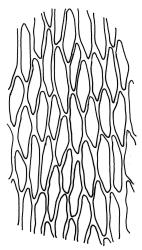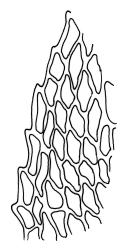- ≡ Hypnum filicinum Hedw., Sp. Musc. Frond. 285 (1801)
- ≡ Amblystegium filicinum (Hedw.) De Not., Comment. Soc. Crittog. Ital. 2: 291 (1867)
Elements in the following description are taken from Hedenäs (2003).
Plants medium-sized, forming loose to dense interwoven mats in seepages, mostly yellow-green above and brown-green below. Stems to at least 45 mm, ascendant, subpinnately branched, beset with scattered ventral fascicles of smooth, brown rhizoids, in cross-section lacking a hyaloderm, with c. 3 layers of firm-walled cortical cells, and a weakly defined central stand; rhizoids mostly abundant, brown, smooth. Branches simple or pinnately branched, irregular in length, mostly <6 mm, occasionally to c. 15 mm. Stem and branch leaves differentiated. Stem leaves erect-spreading or weakly falcate-secund, broadly triangular, gradually narrowed to a broadly subulate and acute apex, narrowed to an auriculate and decurrent base, weakly and bluntly denticulate at basal margins, entire, crenulate or weakly toothed above in N.Z. material, weakly striate when dry, mostly 1.1–1.2 × 0.45–0.55 mm; mid laminal cells unistratose, oblong-hexagonal, mostly 21–25 × c. 6 mm, mostly 3–5:1, firm-walled, lacking pores, smooth in N.Z. material; alar cells enlarged but firm-walled, yellow-brown, abruptly differentiated and forming a large, auriculate, and decurrent group extending nearly to the costa base. Costa stout, 45–60 µm wide at base, disappearing in the subula, in cross-section convex abaxially, weakly convex adaxially, with a median band of guide cells, one adaxial and two abaxial layers of smaller (non-stereid) cells. Branch leaves smaller and narrower, ovate-lanceolate, erect-spreading, neither auriculate nor decurrent at base, mostly c. 0.5–0.75(–1.0) × 0.17–0.25 mm, weakly and rather bluntly toothed throughout; laminal cells little different from those of stem leaves; alar cells weakly inflated and firm-walled, but not forming a distinct group. Axillary hairs sparse. Paraphyllia present but sparse, foliose, broadly lanceolate, irregular, or filiform, toothed at margins, often fragmenting when removed from stem. Pseudoparaphyllia not seen, reportedly foliose.
Dioicous. Perichaetia scattered on stem, c. 0.6 mm long prior to fertilisation (mature perichaetia not seen in N.Z. material). Perigonia scattered on stems. Sporophytes not seen in N.Z. material.
Kanda 1976, fig. 13, 8–20; Crum & Anderson 1981, fig. 466; Ochyra 1989, figs. 1–2.
More compact forms could be confused with Amblystegium serpens, but the strongly differentiated and enlarged alar cells in the stem leaves distinguish the present species, which also occupies a different habitat than the Amblystegium.
Cratoneuron filicinum could also be confused with the common and weedy Eurhynchium praelongum, however the overall habits due to the somewhat falcate-secund or erect-spreading and evenly tapered stem leaves (compared to the widely spreading to squarrose and abruptly tapered stem leaves of the Eurhynchium) distinguish the two. The mid laminal cells of the present species are shorter (c. 21–25 µm) than those of the Eurhynchium (mostly 36–60 µm) and the two species occupy very different habitats.
NI: S Auckland (Waikāretu Valley, southern Kāwhia Harbour), Gisborne (Ruakituri River), Hawke’s Bay (Mōhaka River); SI: Nelson (Mt Arthur, Mt Owen, Ruby Lake), Marlborough (Woodside Creek), Canterbury (Broken River, Castle Hill, Temple Basin), Southland (Takahē Valley); Ch (Pitt I.).
Bipolar? Widespread in the northern hemisphere (Crum & Anderson 1981 and Hedenäs 2003). Reported from North Africa by Kanda (1976) and from many high-elevation sites in the neotropics (Hedenäs 2003).
In N.Z. Cratoneuron filicinum is usually associated with seepages or springs on limestone, but also occurs on clay over (probably cation-rich) sandstone (at Mōhaka River), in seepages over greywacke (as at Temple Basin), and on wet old bricks and concrete in deep shade (as at Pitt I.). At Takahē Valley it formed a dense, tightly adherent golden-brown mat c. 25 × 25 cm on vertical, dripping limestone in subalpine southern beech forest. The occurrence of this species, and several others, on greywacke in Temple Basin suggests elevated cation levels. It has been found in alpine dolines at c. 1500 m on Mt Owen. One collection (Ruby Lake, J.K. Bartlett 21023, WELT M008385) was made from ultrabasic rock at an alpine tarn margin. Few data are available on bryological associates, although Camptochaete pulvinata, Campyliadelphus stellatus, Cratoneuropsis relaxa, and Timmia norvegica have been seen in herbarium packets. Calcareous seepages are the most frequent habitat of this species throughout its world range. It ranges from near sea level to at least 1500 m (Mt Owen).
The scattered N.Z. distribution, including both lowland and alpine sites is unusual, but there are no compelling reasons to believe this species is not indigenous.
N.Z. populations generally have only sparse paraphyllia, and in some collections these may be difficult to observe. Many high elevation collections (e.g., from Temple Basin) have poorly developed stems and thus appear more compact than lowland populations. I have seen only perichaetia containing unfertilised archegonia in N.Z. material. Kanda (1976) described perichaetial leaves (presumably associated with mature sporophytes) in Japanese material as "elongate-lanceolate, ± 3.5 mm long" and capsules as "cylindrical- oblong, rather turgid, 2–2.5 mm long, 1–1.2 mm thick, constricted under mouth, slightly arcuate and more or less sulcate when dry".












